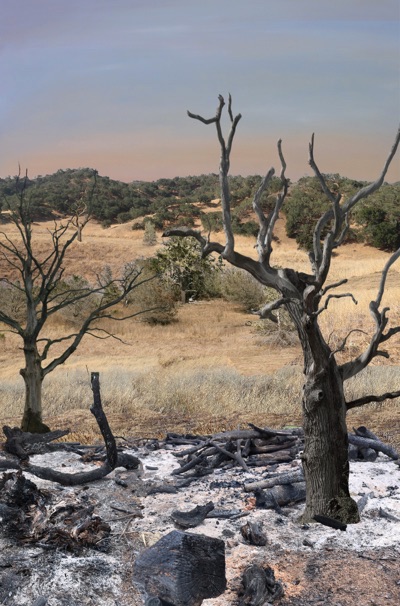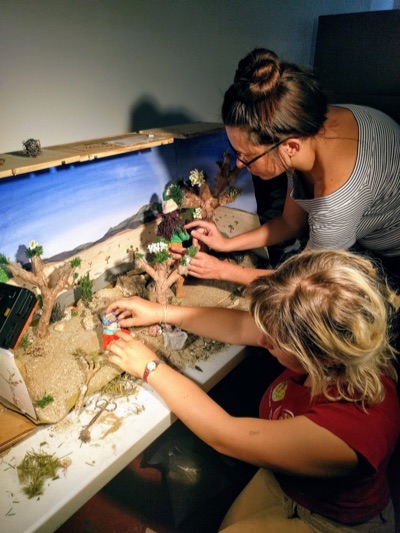Campus News
Public invited to view Norris Center art-science residency projects
Several examples of art-science collaborations will be on view at the Museum of Art and History on Sunday, Nov. 10 from 10-5 p.m. and at the Norris Center for Natural History on Friday and Saturday, Nov. 15-16 from noon to 5 p.m.


For artist Kathleen Deck, illustrating what the redwood forests of Santa Cruz County will look like in the year 2100 seemed like a powerful way to communicate about climate change. But to have maximum impact, she knew her images had to be scientifically accurate.
That’s why Deck teamed up with Alex Jones, manager of the UCSC Campus Natural Reserve. Together, the artist and scientist collaborated on an interactive depiction of the local Coastal Redwood ecosystem, past, present, and future.
Not all art-science collaborations involve virtual time travel, but they do use visual storytelling to enhance public understanding of scientific concepts. Some fine examples from the UCSC Norris Center Art-Science Residency, including Deck’s project, will be on view at the Museum of Art and History (MAH) on Sunday, Nov. 10 from 10-5 p.m. and at the Norris Center for Natural History on Friday and Saturday, Nov. 15-16 from noon to 5 p.m. All events are free and open to the public.
Viewers will learn about topics like tropical forest restoration in Costa Rica, the life histories of Rainbow Trout and Steelhead, the oral storytelling traditions of Micronesia’s outer islands, and gender diversity in marine animals. On display will be artwork that ranges from traditional natural history illustration to stop-motion animation, as well as book projects, infographics, and 3D-printed artificial flowers used in a pollinator experiment.
Evoking an emotional response
Deck, like all of the featured artists, immersed herself in scientific journals and learned as much as she could, but Jones was an invaluable collaborator—even providing the narration in her finished piece.
With Jones’s help, Deck (MFA, ’19, digital art and new media) was able to paint the lush local Coastal Redwood forests as scientists believe they looked in 1500, when grizzly bears and mountain lions roamed the landscape. She also painted the forest as it stands today, following widespread clear-cutting in the 1800s, and how scientists anticipate it will look in 2100 under two scenarios presented by the Intergovernmental Panel on Climate Change: the “best-case” scenario and the “worst-case” scenario. Under both future scenarios, Deck’s depictions of the barren landscape in 2100 make clear the sad fate of Coastal Redwoods: “If we don’t have coastal fog, they’re not going to make it,” she said.
Deck “layered” her paintings with interactive, computer graphics that show temperature, biodiversity, fire frequency, and carbon dioxide parts-per-million over time. Viewers navigate across the images, hovering to learn more about each topic.
“It was an ambitious idea,” said Deck. “Nobody’s doing this. But this is why I make art. Pictures have so much potential to really show us things and to elicit an emotional response to climate change.”
“These collaborations get us out of our silos”
Deck’s project, and the others on display as part of the “Uniting Art and Science to Ignite Inquiry” exhibit, highlight the value of pairing artists and scientists. Some projects, like Deck’s rendering of a future landscape, simply wouldn’t be possible unless an artist is involved, but the benefits run both ways, according to Karen Holl, faculty director of the Norris Center.
“For faculty and graduate student scientists, these collaborations get us out of our silos and help us think differently and communicate in more creative ways,” said Holl. “For student artists, this residency gives them a professional training opportunity and a chance to work with researchers as clients.”
Now in its third year, the residency has produced illustrations that have been published in textbooks and scholarly articles and used in public talks.
The residency, which is unique in the UC system and rare in higher education generally, sponsors six to eight projects per year, with faculty and graduate student scientists proposing projects, according to Juniper Harrower, coordinator of the program. The Norris Center reaches out to student artists, typically attracting 30 or more applications.
“This art-science residency gives scientists a chance to step outside their science-speak without losing the depth, complexity, and rigor of their work,” said Harrower (PhD, ’19, environmental studies), who participated as a graduate student before becoming coordinator. “They get to see their life’s work come to life. And artists bring their expertise, which is really empowering for students.”
A Joshua Tree Love Story
Harrower, who has a professional background as both a scientist and an artist, created a stop-motion animated film that presents her work on Joshua Tree ecology through the lens of her experience as a researcher working in the field. She collaborated with artists Grace Ackles (Porter College ’18, BA art; BA anthropology) and Lauren Benzaquen (MFA, ’19, digital art and new media) to tell the story of how climate change might impact the trees’ symbiotic relationship with pollinating moths and root fungi. The biographical narrative of “A Joshua Tree Love Story” makes the information readily accessible to audiences.
“I’d always dreamed of doing stop-motion animation and thought I might make it as part of my Ph.D. dissertation,” recalled Harrower. “I wanted to use it as a storytelling tool.”
Her first project, a two-minute animation about how tiny moths pollinate the trees, led to an artist-in-residence position at Joshua Tree National Park with Interpreters and Scientists Working On Our Parks (iSWOOP) and the inspiration to make a new film that incorporates a more human narrative into the story.
“People told me that I should be part of the story, because I was pregnant or carrying my baby on my back during my field research and the residency,” said Harrower. That multi-generational element of the story highlights the plight of the trees, all of which could be gone within 100 years because of climate change, she said.
“That emotional, social narrative allows people to connect on a different level,” said Harrower. “It still has all the science, but it is part of a bigger narrative.”
Working with Ackles and Benzaquen was empowering for Harrower, too, as the artists shared their talents. “We workshopped what’s possible, how to tell the story and show the science,” she said. “The animators had the background to think about what was possible, and to explore how to communicate in metaphorical and engaging ways.”
The film, and some of the diorama sets and sculptures used to create it, is also being featured as the inaugural show at the new Black Rock Art Gallery in Joshua Tree National Park; that exhibit runs through January 20, 2020.